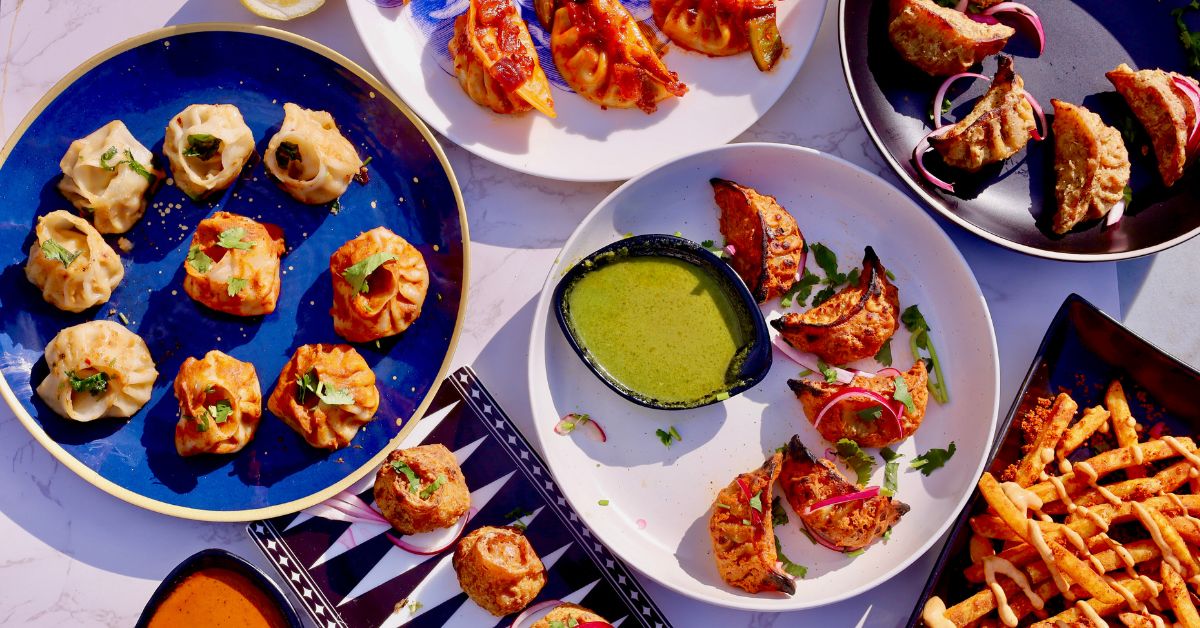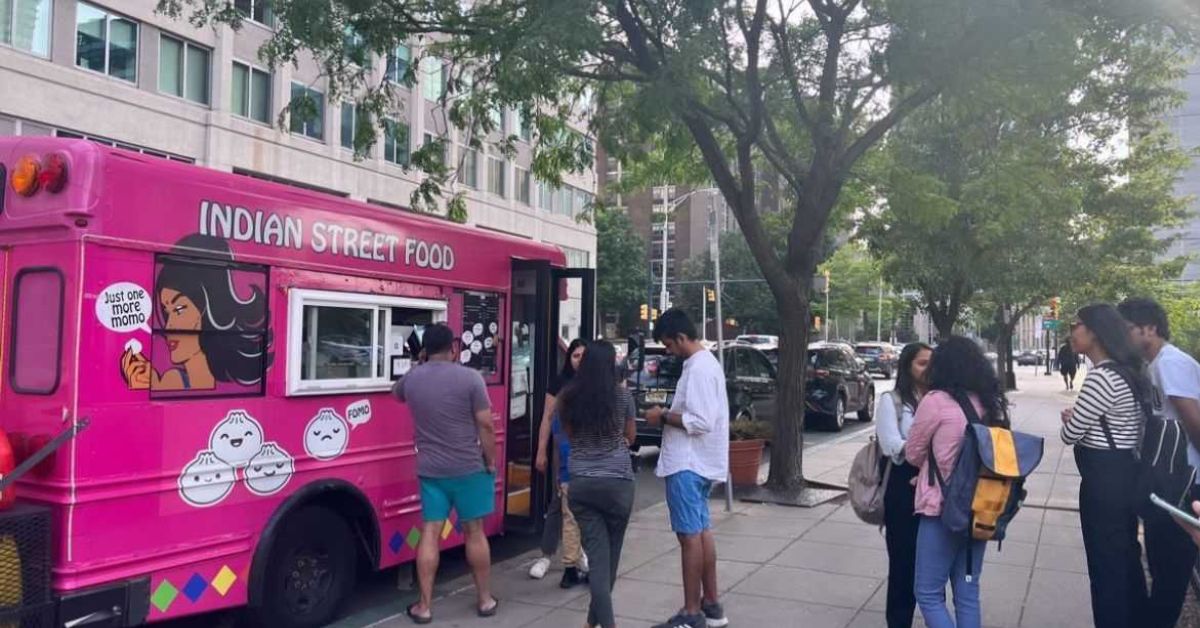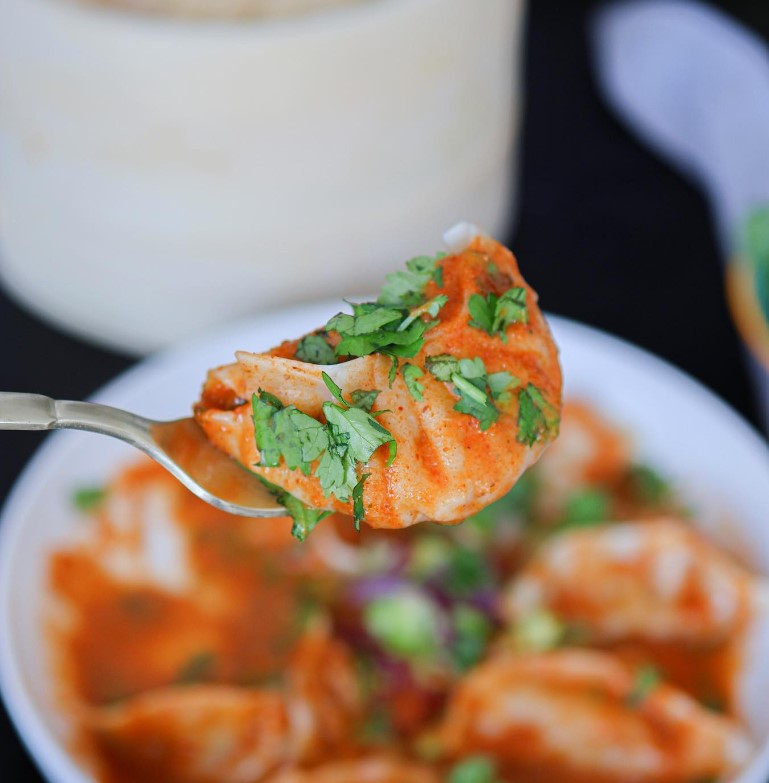On any given day the streets of New Jersey are bustling — office goers rushing in an attempt to skip the traffic jam, the consistent hum drum of buses, the chatter of school kids, regular joggers trying to cram in those few extra minutes before the day begins.
Interspersed in these moments of hustle is the smell of coffee wafting from the cafes that line the sidewalk, the aroma acting like a beacon that draws to it all the above.
Keenly watching this whole scene unfold is a woman. Her desi attire is suggestive of her origins. Her gaze is unwavering as she watches the cacophony of the northeastern US state. One might say her position on the side of the vibrant pink food truck is strategic, considering the view of 400 Central Ave, Jersey City she has from there.
Behind the pink doors beside her illustration, magic is steamed (and fried) every day by a duo of Indian origin. The variety of momos whipped up in the food truck borrow their taste from the that Ankita Nagpal —- one half of the duo that helms the ‘Fomo Momo’ venture — feasted on when she was a child growing up in Delhi.
Her business partner and friend, Impreet Sodhi, and she watch smilingly as the residents of New Jersey tackle plates after plates of their momos every day from 3 pm to 9 pm. What is astounding is that the duo operate this very successful venture whilst juggling full-time jobs as tech professionals.

The Fomo Momo food truck in New Jersey, United States, Picture source: Ankita
“The you’ve had in India have got to be the ones from Delhi, right?” Ankita asks me, daring me to counter this. “Yes,” I replied truthfully, seemingly pleasing her with the answer.
Growing up, Ankita spent her weekends sampling street food across the bazaars of the national capital. But the momos remained her favourite. So, years later, when she met Impreet in the US at a dinner organised by their husbands, who are college friends, and the latter proclaimed her love for momos, Ankita knew she had found her food soulmate.
“It was that conversation that gave us the idea of bringing from Delhi to the US,” Ankita shares. Throughout the journey of setting up this food truck, the duo has been keen on showing the world how amazing the flavours of Indian momos are, and how diversified they can be in the palates they cater to.

The momo varieties include butter garlic momos, tandoori momos, Picture source: Ankita
They say the food truck was simply a eureka moment that tied their passion and ideas together.
But changing gears from the venture being a mere idea to a full-blown food truck was a challenge, Impreet admits. The biggest hurdle was visibility. “I think our first challenge was to capture the market. If you look at it, even in India itself, in North India while people of South India are not as well acquainted with the dish. Similarly, here in New Jersey, we noticed that there are some Americans who are familiar with the dish while several immigrants aren’t,” Ankita adds.
To navigate through this, the duo began giving out free samples in the initial days of setting up. And to everyone who asked what the difference between the sample (momo) and a dumpling was, they would patiently explain.
With a unique story of origin and an equally unique taste, the three culinary delights are so different, yet so similar.
Dim sums refer to the broad category of bite-sized dishes in Chinese cuisine, with a thin casing enveloping the stuffing of meat, seafood or vegetables. Dumplings fall under the category of dim sums and refer to dough pockets that can be fried, baked or steamed. Momos, on the other hand, have the most coloured history of the three.

The customers at Fomo Momo include college students, working professionals across the diaspora, Picture source: Ankita
Having originated in Tibet as early as the 14th century, these local delicacies came to India in the 1960s when a large number of Tibetans settled in Sikkim, Darjeeling, Delhi, Ladakh and Dharamshala. Another theory suggests that the Newar merchants of Kathmandu brought the momos to India from Tibet and Nepal during their travels.
Today, numerous variations exist. These range from tandoori momos paired with red chilli chutney and mayonnaise, Afghani momos which are a sweeter and creamier version of tandoori momos, steamed jhol momos that are served in soup in Nepal, that are tossed in chilli sauce and ketchup, Kothey momos that are pan-fried and belong to the Himalayas and have a strong ginger flavour. The list goes on and on.
And it is this magic that Ankita and Impreet are bringing to New Jersey.

The makhani momos are loved for their creamy and tangy taste that finds favour in American and Indian palates, Picture source: Ankita
It is amusing to watch Americans whose palates love more subtle flavours, gorging on the spicy tandoori momos at the Fomo Momo food truck. Ankita and Impreet love watching the scene as they strike a friendly banter with their clientele. They can often tell what a person is going to order, based on their past favourites and often have the order ready to go! Helming a food truck comes with these moments, they add.
Once considered a ramshackle, food trucks are starting to be increasingly popular around New Jersey and the United States. They provide outlets for relationship building with customers, something that isn’t as possible in a traditional brick-and-mortar setting. That being said, running a food truck, where the wind and weather often play spoilsport, is tougher than a traditional storefront, says the duo.

One of the best-selling momos is the chilli momo that is loved for the spicy chutney it comes with, Picture source: Ankita
“There are many logistics. Someone is needed in the kitchen to prepare the food, a driver is needed to navigate the truck from one location to the other, over a dozen people are working inside the truck at all times; it is a challenge,” Ankita admits.
But, that being said, it also gives the duo a chance to bond with their customers. Perhaps it is these bonding moments that are the reason for Fomo Momo’s business thriving from the outset. Recalling the first customers they served, Ankita says it was at the Smorgasburg Food Festival in Jersey City in 2021. “This seemed a great option as food festivals attract people who want to taste items from all across the world,” she notes.

Ankita Nagpal and Impreet Sodhi run the Fomo Momo food truck in New Jersey, Picture source: Ankita
So, at the food festival, amidst the stalls that had Filipino food, Mexican food, Japanese food and more, there was a stall for . And Ankita and Impreet watched with bated breath as people came to see what the hype was all about.
“It gave us a chance to test the market. What we observed was that though people did not know much about the momos, they wanted to try it out. Once they sampled it, they would return for some more. We developed a small fan base,” they share.
Sensing that the idea would do well, the duo bought a food truck and started a business in 2023.
However, they add that they continue to serve momos at the World Trade Centre’s food festival in New York that runs from April through October. To cater to every diaspora, the menu is divided into subtle options. For instance, the butter garlic momos are a hit with the Americans while the spicier options suit the Indian palate.
They emphasise, however, that perfecting the momo recipe has been a challenge. Eight months of experimenting finally led them to come up with a momo that had the ideal wrapper size, one that wasn’t too chewy but at the same time thick enough to hold the herbs and spices and veggies, and of course a momo that ticked all the boxes for taste.
Nevertheless, the journey has been telling. As the clock strikes 5 pm, Ankita and Impreet brace themselves for the office crowd that will soon be stopping at the food truck for their snack. The sizzles and chopping sounds travel through the call as they prepare the fillings for the momos for the hungry customers who will soon be there.
Edited by Padmashree Pande
Interspersed in these moments of hustle is the smell of coffee wafting from the cafes that line the sidewalk, the aroma acting like a beacon that draws to it all the above.
Keenly watching this whole scene unfold is a woman. Her desi attire is suggestive of her origins. Her gaze is unwavering as she watches the cacophony of the northeastern US state. One might say her position on the side of the vibrant pink food truck is strategic, considering the view of 400 Central Ave, Jersey City she has from there.
Behind the pink doors beside her illustration, magic is steamed (and fried) every day by a duo of Indian origin. The variety of momos whipped up in the food truck borrow their taste from the that Ankita Nagpal —- one half of the duo that helms the ‘Fomo Momo’ venture — feasted on when she was a child growing up in Delhi.
Her business partner and friend, Impreet Sodhi, and she watch smilingly as the residents of New Jersey tackle plates after plates of their momos every day from 3 pm to 9 pm. What is astounding is that the duo operate this very successful venture whilst juggling full-time jobs as tech professionals.

The Fomo Momo food truck in New Jersey, United States, Picture source: Ankita
A penchant for momos
“The you’ve had in India have got to be the ones from Delhi, right?” Ankita asks me, daring me to counter this. “Yes,” I replied truthfully, seemingly pleasing her with the answer.
Growing up, Ankita spent her weekends sampling street food across the bazaars of the national capital. But the momos remained her favourite. So, years later, when she met Impreet in the US at a dinner organised by their husbands, who are college friends, and the latter proclaimed her love for momos, Ankita knew she had found her food soulmate.
“It was that conversation that gave us the idea of bringing from Delhi to the US,” Ankita shares. Throughout the journey of setting up this food truck, the duo has been keen on showing the world how amazing the flavours of Indian momos are, and how diversified they can be in the palates they cater to.

The momo varieties include butter garlic momos, tandoori momos, Picture source: Ankita
They say the food truck was simply a eureka moment that tied their passion and ideas together.
But changing gears from the venture being a mere idea to a full-blown food truck was a challenge, Impreet admits. The biggest hurdle was visibility. “I think our first challenge was to capture the market. If you look at it, even in India itself, in North India while people of South India are not as well acquainted with the dish. Similarly, here in New Jersey, we noticed that there are some Americans who are familiar with the dish while several immigrants aren’t,” Ankita adds.
To navigate through this, the duo began giving out free samples in the initial days of setting up. And to everyone who asked what the difference between the sample (momo) and a dumpling was, they would patiently explain.
What sets a dumpling, momo and dim sum apart?
With a unique story of origin and an equally unique taste, the three culinary delights are so different, yet so similar.
Dim sums refer to the broad category of bite-sized dishes in Chinese cuisine, with a thin casing enveloping the stuffing of meat, seafood or vegetables. Dumplings fall under the category of dim sums and refer to dough pockets that can be fried, baked or steamed. Momos, on the other hand, have the most coloured history of the three.

The customers at Fomo Momo include college students, working professionals across the diaspora, Picture source: Ankita
Having originated in Tibet as early as the 14th century, these local delicacies came to India in the 1960s when a large number of Tibetans settled in Sikkim, Darjeeling, Delhi, Ladakh and Dharamshala. Another theory suggests that the Newar merchants of Kathmandu brought the momos to India from Tibet and Nepal during their travels.
Today, numerous variations exist. These range from tandoori momos paired with red chilli chutney and mayonnaise, Afghani momos which are a sweeter and creamier version of tandoori momos, steamed jhol momos that are served in soup in Nepal, that are tossed in chilli sauce and ketchup, Kothey momos that are pan-fried and belong to the Himalayas and have a strong ginger flavour. The list goes on and on.
And it is this magic that Ankita and Impreet are bringing to New Jersey.

The makhani momos are loved for their creamy and tangy taste that finds favour in American and Indian palates, Picture source: Ankita
Crafting a unique menu
It is amusing to watch Americans whose palates love more subtle flavours, gorging on the spicy tandoori momos at the Fomo Momo food truck. Ankita and Impreet love watching the scene as they strike a friendly banter with their clientele. They can often tell what a person is going to order, based on their past favourites and often have the order ready to go! Helming a food truck comes with these moments, they add.
Once considered a ramshackle, food trucks are starting to be increasingly popular around New Jersey and the United States. They provide outlets for relationship building with customers, something that isn’t as possible in a traditional brick-and-mortar setting. That being said, running a food truck, where the wind and weather often play spoilsport, is tougher than a traditional storefront, says the duo.

One of the best-selling momos is the chilli momo that is loved for the spicy chutney it comes with, Picture source: Ankita
“There are many logistics. Someone is needed in the kitchen to prepare the food, a driver is needed to navigate the truck from one location to the other, over a dozen people are working inside the truck at all times; it is a challenge,” Ankita admits.
But, that being said, it also gives the duo a chance to bond with their customers. Perhaps it is these bonding moments that are the reason for Fomo Momo’s business thriving from the outset. Recalling the first customers they served, Ankita says it was at the Smorgasburg Food Festival in Jersey City in 2021. “This seemed a great option as food festivals attract people who want to taste items from all across the world,” she notes.

Ankita Nagpal and Impreet Sodhi run the Fomo Momo food truck in New Jersey, Picture source: Ankita
So, at the food festival, amidst the stalls that had Filipino food, Mexican food, Japanese food and more, there was a stall for . And Ankita and Impreet watched with bated breath as people came to see what the hype was all about.
“It gave us a chance to test the market. What we observed was that though people did not know much about the momos, they wanted to try it out. Once they sampled it, they would return for some more. We developed a small fan base,” they share.
Sensing that the idea would do well, the duo bought a food truck and started a business in 2023.
However, they add that they continue to serve momos at the World Trade Centre’s food festival in New York that runs from April through October. To cater to every diaspora, the menu is divided into subtle options. For instance, the butter garlic momos are a hit with the Americans while the spicier options suit the Indian palate.
They emphasise, however, that perfecting the momo recipe has been a challenge. Eight months of experimenting finally led them to come up with a momo that had the ideal wrapper size, one that wasn’t too chewy but at the same time thick enough to hold the herbs and spices and veggies, and of course a momo that ticked all the boxes for taste.
Nevertheless, the journey has been telling. As the clock strikes 5 pm, Ankita and Impreet brace themselves for the office crowd that will soon be stopping at the food truck for their snack. The sizzles and chopping sounds travel through the call as they prepare the fillings for the momos for the hungry customers who will soon be there.
Edited by Padmashree Pande
